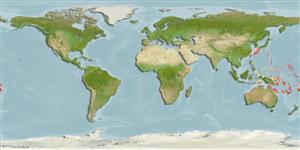>
Eupercaria/misc (Various families in series Eupercaria) >
Lutjanidae (Snappers) > Apsilinae
Etymology: Paracaesio: Greek, para = the side of + Latin, caesium = bluish grey (Ref. 45335).
Environment: milieu / climate zone / depth range / distribution range
Écologie
marin bathydémersal; profondeur 200 - 320 m (Ref. 9821), usually 200 - 250 m (Ref. 82366). Deep-water; 32°N - 22°S, 124°E - 177°W (Ref. 55)
Western Pacific: off the Ryukyu Islands to northeastern Australia and Samoa.
Length at first maturity / Taille / Poids / Âge
Maturity: Lm 40.0 range ? - ? cm
Max length : 50.0 cm SL mâle / non sexé; (Ref. 9821)
Épines dorsales (Total): 10; Rayons mous dorsaux (Total): 10; Épines anales 3; Rayons mous anaux: 8. Eye large; snout short (shorter than eye diameter). Interorbital space slightly convex. Lower jaw protruding slightly. Scale rows on back parallel to lateral line. Pectoral fins long, reaching level of anus. Back and upper sides light brown, silvery on lower sides and belly; five brown vertical bars on the upper side; the fins are gray to whitish; the margin of the dorsal fin and most of the caudal fin yellow.
Adults are found on the continental shelf and continental slope (Ref. 75154).
Life cycle and mating behavior
Maturité | Reproduction | Frai | Œufs | Fécondité | Larves
Allen, G.R., 1985. FAO Species Catalogue. Vol. 6. Snappers of the world. An annotated and illustrated catalogue of lutjanid species known to date. FAO Fish. Synop. 125(6):208 p. Rome: FAO. (Ref. 55)
Statut dans la liste rouge de l'IUCN (Ref. 130435)
Menace pour l'homme
Harmless
Utilisations par l'homme
Pêcheries: pêcheries vivrières
Plus d'informations
RéférencesAquacultureProfil d'aquacultureSouchesGénétiqueElectrophoresesHéritabilitéPathologiesTraitementNutrientsMass conversion
CollaborateursImagesStamps, Coins Misc.SonsCiguateraVitesseType de nageSurface branchialeOtolithesCerveauxVision
Outils
Articles particuliers
Télécharger en XML
Sources Internet
Estimates based on models
Preferred temperature (Ref.
123201): 18.3 - 21.1, mean 18.9 °C (based on 7 cells).
Phylogenetic diversity index (Ref.
82804): PD
50 = 0.5039 [Uniqueness, from 0.5 = low to 2.0 = high].
Bayesian length-weight: a=0.03388 (0.01545 - 0.07431), b=2.88 (2.68 - 3.08), in cm total length, based on LWR estimates for this species & (Sub)family-body (Ref.
93245).
Niveau trophique (Ref.
69278): 4.0 ±0.66 se; based on food items.
Generation time: 5.5 ( na - na) years. Estimated as median ln(3)/K based on 1
growth studies.
Résilience (Ref.
120179): Milieu, temps minimum de doublement de population : 1,4 à 4,4 années (Preliminary K or Fecundity.).
Fishing Vulnerability (Ref.
59153): Moderate to high vulnerability (50 of 100).
Nutrients (Ref.
124155): Calcium = 21.2 [10.2, 51.2] mg/100g; Iron = 0.38 [0.14, 0.88] mg/100g; Protein = 17.4 [15.4, 19.3] %; Omega3 = 0.297 [0.134, 0.609] g/100g; Selenium = 15.8 [6.7, 37.8] μg/100g; VitaminA = 8.28 [1.38, 57.57] μg/100g; Zinc = 0.325 [0.204, 0.511] mg/100g (wet weight);
